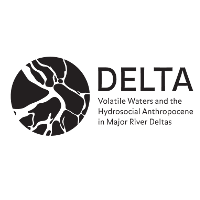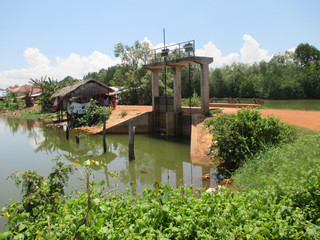On our second lab session, we explore the puzzling world of infrastructure. This blog post reflects some ideas, thoughts and arguments that intersect with the research we’re doing on deltas.
Larkin, B., 2013. The Politics and Poetics of Infrastructure. Annual Review of Anthropology 42, 327–343.
In his paper, Larkin argues that infrastructures are more than just things upon which other things run or operate. They have a particular ontology that lies in the fact that they are both things and also the relations between things. Infrastructures become a central force in shifting ground for the phenomenal world, connecting places, smoothing peoples and objects. At the same time, they offer ground to affective relations and political imaginaries, they animate and are animated by the world. They assemble, enlarge and generate particular forms of relational, cultural and sensory experiences and can constitute belonging. This is partly why it would be insufficient to view infrastructural work as only instrumental. The politics of infrastructure is also in emotional tensions and expressions. Looking to the poetics and aesthetics of infrastructure is hence acknowledging that it can be something else than just the background.
Besides, far from being invisible as it is most commonly viewed, infrastructure may well be very spectacular. As such, we might better think of invisibility as one form that can define infrastructure among the multiplicities of appearances and aspects that it has, both in imaginaries and practices. According to Larkin, infrastructure is not simply out there, either seen or unseen. What is or becomes infrastructure, what is visible or not, has much to do with who the person is, his position, experience and interest. All (in)visibility is hence situated. Behind irrigation systems that convey water, there is simultaneously a helpful device for farmers, a cumbersome system to maintain for irrigation officers or water users, and a spectacular world for engineers. There is accordingly a politics of invisibility and happening around infrastructure, which can be blended through action, manipulation, resistance or sabotage. This provokes important questions for our research about deltas such as: whose infrastructure? Whose invisibility? But also, whose delta? Taking into consideration that infrastructures are operating at multiple levels at once, also raises questions about how to approach and engage with infrastructure, that is how to define which levels to examine. As Larkin emphasizes, “the act of defining an infrastructure is a categorizing moment”.
Jensen, C.B., Morita, A., 2016. Infrastructures as Ontological Experiments. Ethnos 1–12.
Jensen and Morita’s paper takes the form of a response to Brian Larkin’s invitation to explore the politics and poetics of infrastructure. While Larkin discusses the particular ontology of infrastructure, they view infrastructures as emergent systems that produce novel configurations of the world – ‘new practical ontologies’. Their point is that the contours of infrastructures continuously emerge and become; likewise, the contours of the worlds. Infrastructures are transformation sites, they change, and in so doing, they also transform the relations and elements altogether. Infrastructure making is thus conceived of experimental systems in which both the human and the nonhuman are taken as open-endedly becoming, grasping emergent configurations. There is a part of surprise in the process, meaning that infrastructures, as much as the world, are still in the making. Because they generate new configurations of the world, new practical ontologies, infrastructures change the very nature of the world we inhabit, including the shape of politics and power. Infrastructural interventions hence turn ontological. This cast fresh light on the making of delta worlds but also on how people come to know and live deltas. Indeed, as much as the infrastructures that have come to define it, deltas are caught up in the flow of becoming. Alongside, Jensen and Morita argue that a focus on the poetics of infrastructure does not enable to grapple with the many non-human agents that gravitate around, and help constitute infrastructures. Yet, as Larkin emphasized himself, infrastructure embodies the relations and interactions between elements, which are not exclusive of nonhuman others. We might even need the sort of poetics necessary for capturing the ephemarilities at the margins of the human and nonhuman realms, in hybrid landscapes such as deltas.
Morita, A., 2016. Infrastructuring Amphibious Space: The Interplay of Aquatic and Terrestrial Infrastructures in the Chao Phraya Delta in Thailand. Science as Culture 25, 117–140.
Atsuro Morita offers a historical perspective of infrastructure development in the Chao Phraya delta in Thailand. Environments such as deltas overthrow the boundaries of land and water, and can be seen alternatively as an extension of the sea or as reclaimable land. The in-between state of deltaic landscapes makes it possible for two different forms of infrastructural orientations that shape life in radically different ways: ‘aquatic’ (water-based) infrastructures characterized by watercourses and flood adaptive housing and ‘terrestrial’ (land-based) infrastructures centered on land-based transport networks and urban planning. For these two types of infrastructure, relation with land/water vary considerably. Terrestrial orientation that often epitomized symbols of modernity implies an idea of separation between land and water, fresh and saline water, meaning that seas and rivers can be contained. Recent floods in Thailand have yet revealed the vulnerability of these terrestrial infrastructures, while foregrounding the resilience of the original aquatic infrastructure and its role for regulating the flows of water and traffic. Most interestingly, the damages of floods highlighted the interplay between both infrastructures, and in this case, their weak coordination. Morita invites us to think of the different set of activities, practices and interactions brought by infrastructures and how they may affect the ways of seeing and enacting deltas. There might be different definitions of what a delta is or can be, something that Morita traces through the different stages of infrastructuring. Yet, we might ask whether the binary between the aquatic and the terrestrial afford the multiple realities of deltas? Is there any rise of a third-way in the nuances of land reclamation and extension of the sea? Discussing infrastructure would it not be already a categorical act when approaching deltas (cf. Larkin)?
Carse, A., Lewis, J.A., 2016. Toward a political ecology of infrastructure standards: Or, how to think about ships, waterways, sediment, and communities together. Environment and Planning A.
Carse and Lewis give a fascinating view on how socioecological change, standards, codes and other aspects of infrastructures are embedded and negotiated across multiple locations. Using a political ecology approach, they trace the historical construction of an ‘infrastructural zone’ around the expansion of the Panama Canal. By setting waterways standards the Panama Canal breaks new paths for global maritime transportation systems. It creates an infrastructural zone within which various sociotechnical systems and geographies get connected. The Panama Canal infrastructure display, so to speak, a halo of resonance. Due to its position along maritime trade routes, it exerts a strong power of attraction upon transportation industries, ports communities and other maritime businesses from the US Atlantic and Gulf Coasts which have to align with the shipping norms and rules in order to read the Panama ships. Dredging operations of navigable waterways, excavation of huge volumes of sediments to facilitate cargo transportation are illustrating of such efforts to achieve a resonance with the standards set by the Panama Canal infrastructure. These projects typically reflect how processes of infrastructure at one scale impact those at much larger scales. This raises, in turn, important questions about what is won and loss along infrastructure making. At the margins of the infrastructural zone, concurrent conflicts over environment and contestations emerge. They bring to the fore the large scale processes in which different actors stake their claims, both ecologically and economically. This analytic akin to “a political ecology of resonance” can be useful for the study of delta infrastructuring as it allows to interrogate who win and who loses in the process, but also the ecological changes that underpin it.
References
Carse, A., Lewis, J.A., 2016. Toward a political ecology of infrastructure standards: Or, how to think about ships, waterways, sediment, and communities together. Environment and Planning A.
Jensen, C.B., Morita, A., 2016. Infrastructures as Ontological Experiments. Ethnos 1–12.
Larkin, B., 2013. The Politics and Poetics of Infrastructure. Annual Review of Anthropology 42, 327–343.
Morita, A., 2016. Infrastructuring Amphibious Space: The Interplay of Aquatic and Terrestrial Infrastructures in the Chao Phraya Delta in Thailand. Science as Culture 25, 117–140.

